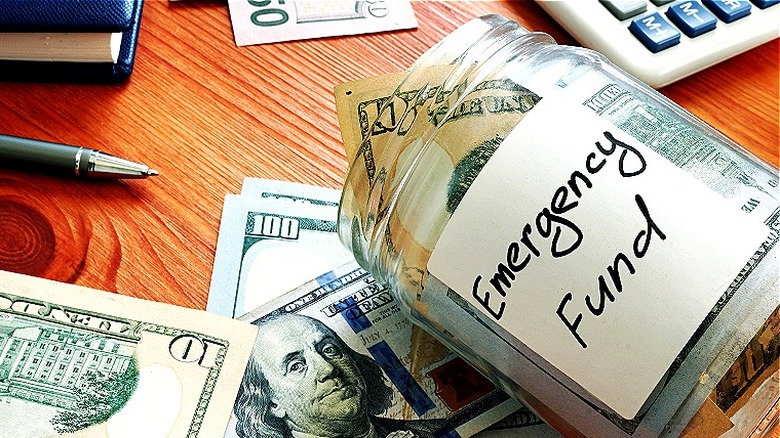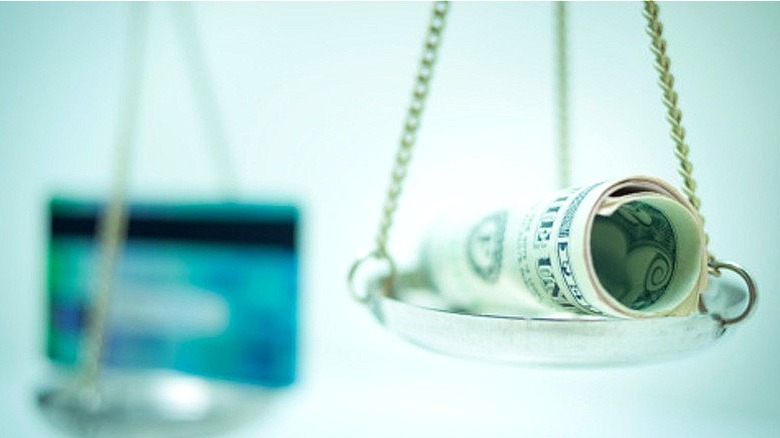Is It Best To Pay Off Debt Or Start Saving First?
If you've accumulated a significant amount of debt — credit cards, student loans, or perhaps a car loan — but you don't have much savings, you might be wondering where you should best focus your limited financial resources. Is it better to start building a cushion of savings for the future, as well as potential emergencies? Or should you pay down your expensive debt first before you start saving? For the average person, the best strategy is to do both simultaneously.
To free up funds for savings and debt repayment, consider budgeting using the 50/30/20 rule. With this method, half your income goes toward necessities, such as groceries and housing. The 30% goes toward wants, such as entertainment and vacations, while the final 20% is earmarked toward savings, investments, and paying down debt. Depending on the severity of your debt situation, you may want to consider reducing spending in the "wants" category, at least initially, to get a jump start on debt repayment and saving.
You should have an emergency fund
It's popular advice among personal finance experts to create an emergency fund to cover a job loss, an unexpected medical expense, or even a pricey car repair. Without an emergency fund, you could be reliant on high interest rate credit cards or personal loans if you suddenly need cash. A traditional benchmark for emergency funds is to accumulate enough savings to cover six months worth of living expenses. That's a daunting goal for many earners nowadays with the increased cost of housing and, well, just about everything due to inflation. Instead, aim for a three-month cushion of savings. You can always add more savings later once your debt levels are lower.
Finally, don't just keep your emergency fund money under the mattress or inside of a cookie jar. Opening up a high-yield savings account will let your money grow over time and it's a great first step toward a culture of saving and investing. Nowadays — for the first time in years — savings accounts are available that pay in excess of 4% or even 5% interest on deposits, so take advantage. Smart savers will seek out those high-yield offers online, as your local bank or credit union may have inferior lower rates.
Choose a technique for debt repayment
There are two common approaches to paying down debt: the snowball method and the avalanche method. The snowball method involves paying off the smallest debts first, without regard to interest rates or other factors. Once the smallest debt is satisfied, begin paying down the second-smallest debt and so on. While perhaps not the most cost-effective strategy, this technique emphasizes the satisfaction and motivational benefits of seeing your debt lessen, which can hopefully lead to the formation of better habits.
On the other hand, the avalanche method for debt repayment focuses on prioritizing debts that carry the highest interest rates, regardless of the balance of those loans. This can be particularly effective if you're carrying high credit card balances, payday loans, or rent-to-own, all of which can easily have an interest rate of more than 20%.
Later on, other types of obligations with lower interest rates can be repaid, like car notes or student loans. Regardless of which method you choose, be sure to stay up to date on all your bills and make at least the minimum payment on all debt obligations to avoid unnecessary late fees or damage to your credit score.
Balancing debt payment with savings
The common challenge for many Americans today is that debt levels are high relative to incomes. It can be extremely discouraging to learn that paying off your current debts will take many years, even with no money set aside toward savings. Indeed, it is smart to pay off high-interest debt as quickly as possible since the interest rates you're paying the lender often exceed the interest rates you'll receive on savings, even with today's high-yield savings account. For example, 5% interest income received from a savings account will quickly evaporate if you're paying 20% interest on credit card balances.
That said, you should strive to accumulate some savings, even if it means paying down debt a little more slowly. Many Americans want to get married, possibly have a family, or purchase a home — all of which takes savings. Ditto for unexpected health issues or perhaps helping an aging parent. It's not always realistic to delay saving (beyond what have in an emergency fund) for these situations until 100% of your debt is paid off, which could take many years.
Finally, if your employer offers a matched contribution into an IRA or 401(k) retirement account, take it, even if that means skimping a bit in other areas. A typical employer-matched contribution is approximately 3% to 6% of your salary. Assuming it's a 5% match, that means if you contribute 5% of your salary toward retirement, your employer also contributes 5%. It's literally free money.



